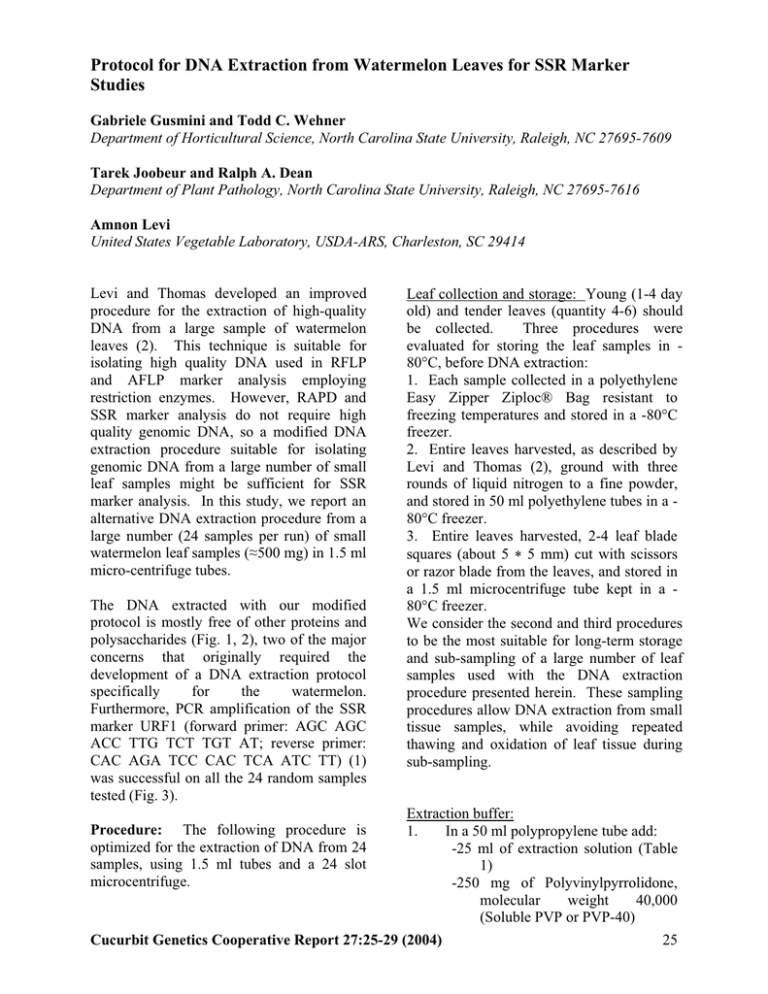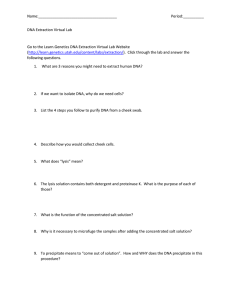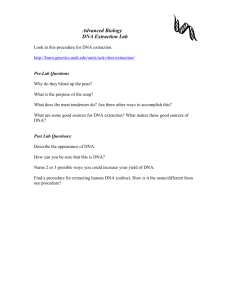Protocol for DNA Extraction from Watermelon Leaves for SSR Marker Studies
advertisement

Protocol for DNA Extraction from Watermelon Leaves for SSR Marker Studies Gabriele Gusmini and Todd C. Wehner Department of Horticultural Science, North Carolina State University, Raleigh, NC 27695-7609 Tarek Joobeur and Ralph A. Dean Department of Plant Pathology, North Carolina State University, Raleigh, NC 27695-7616 Amnon Levi United States Vegetable Laboratory, USDA-ARS, Charleston, SC 29414 Levi and Thomas developed an improved procedure for the extraction of high-quality DNA from a large sample of watermelon leaves (2). This technique is suitable for isolating high quality DNA used in RFLP and AFLP marker analysis employing restriction enzymes. However, RAPD and SSR marker analysis do not require high quality genomic DNA, so a modified DNA extraction procedure suitable for isolating genomic DNA from a large number of small leaf samples might be sufficient for SSR marker analysis. In this study, we report an alternative DNA extraction procedure from a large number (24 samples per run) of small watermelon leaf samples (§500 mg) in 1.5 ml micro-centrifuge tubes. The DNA extracted with our modified protocol is mostly free of other proteins and polysaccharides (Fig. 1, 2), two of the major concerns that originally required the development of a DNA extraction protocol specifically for the watermelon. Furthermore, PCR amplification of the SSR marker URF1 (forward primer: AGC AGC ACC TTG TCT TGT AT; reverse primer: CAC AGA TCC CAC TCA ATC TT) (1) was successful on all the 24 random samples tested (Fig. 3). Leaf collection and storage: Young (1-4 day old) and tender leaves (quantity 4-6) should be collected. Three procedures were evaluated for storing the leaf samples in 80°C, before DNA extraction: 1. Each sample collected in a polyethylene Easy Zipper Ziploc® Bag resistant to freezing temperatures and stored in a -80°C freezer. 2. Entire leaves harvested, as described by Levi and Thomas (2), ground with three rounds of liquid nitrogen to a fine powder, and stored in 50 ml polyethylene tubes in a 80°C freezer. 3. Entire leaves harvested, 2-4 leaf blade squares (about 5 5 mm) cut with scissors or razor blade from the leaves, and stored in a 1.5 ml microcentrifuge tube kept in a 80°C freezer. We consider the second and third procedures to be the most suitable for long-term storage and sub-sampling of a large number of leaf samples used with the DNA extraction procedure presented herein. These sampling procedures allow DNA extraction from small tissue samples, while avoiding repeated thawing and oxidation of leaf tissue during sub-sampling. Extraction buffer: 1. In a 50 ml polypropylene tube add: -25 ml of extraction solution (Table 1) -250 mg of Polyvinylpyrrolidone, molecular weight 40,000 (Soluble PVP or PVP-40) 25 Cucurbit Genetics Cooperative Report 27:25-29 (2004) Procedure: The following procedure is optimized for the extraction of DNA from 24 samples, using 1.5 ml tubes and a 24 slot microcentrifuge. -250 mg Polyvinylpolypyrrolidone (Insoluble PVP or PVPP) (250 mg) 2. Incubate for 10-15 minutes at 60°C and mix vigorously 3. After incubation add 125 Pl of 2% EMercaptoethanol 4. Incubate at 60°C 6. 7. DNA extraction procedure: 1. Add 700 Pl of extraction buffer to 50100 mg of leaf tissue (intact or previously ground with liquid nitrogen) in 1.5 ml microcentrifuge tubes; use P1000 pipette tips, cut at 1/3 of their length. 2. Homogenize each sample: a. If starting from intact leaf tissue, add quartz or glass sand (the tip of a spatula) and homogenize using a Kontes™ Pellet Pestle™. In this case, it is very important to use tissue from very young leaves (14 days). b. If starting from leaf tissue previously ground with liquid nitrogen, vortex gently. 3. Incubate for 30 minutes at 60°C and vortex vigorously every 10 minutes. 4. Add to each sample 500 Pl of Chloroform:Isoamyl Alcohol (24:1). 5. Vortex vigorously until the mix color turns homogeneous and light-green; release gas and reseal the cap. 12. 8. 9. 10. 11. 13. 14. 15. 16. Centrifuge for 5 minutes at 12,500 rpm. Transfer the supernatant from each sample (§500 Pl) to new 1.5 ml tubes. Add to each sample 500 Pl (or 1 volume) of ice-cold Isopropanol. Mix gently by inversion. Incubate for 20 minutes at -20°C. Centrifuge for 15 minutes at 12,500 rpm. Pour supernatant and suspend the pellets in 500 Pl 70% ethanol. Centrifuge for 15 minutes at 12,500 rpm. Pour supernatant and dry the pellets at room-temperature then suspend in 100 Pl of 0.1X TE. Centrifuge for 5 minutes at 12,500 rpm. Transfer the supernatant from each sample to a new container for final storage (0.5 ml microcentrifuge tubes or 96-well plates). Literature Cited 1. Guerra-Sanz, J. M. 2002. Citrullus simple sequence repeats markers from sequence databases. Molecular Ecology Notes 2(3):223-225. 2. Levi, A., and C. Thomas. 1999. An improved procedure for isolation of high quality DNA from watermelon and melon leaves. Cucurbit Genetics Cooperative Report 22:41-42. Cucurbit Genetics Cooperative Report 27:25-29 (2004) 26 Table 1. Extraction solution for fast DNA extractions from watermelon leaves for SSR marker studies. Reagent [Final] Tris-base a Sarcosil b NaCl EDTA disodium CTAB c 0.1 0.5 1.4 20.0 2.5 g/l M % M mM % Notes 12.10 5.00 81.82 5.57 25.00 pH=8.5 Pour slowly a Tris hydroxymethyl aminomethane N-Lauroylsarcosine c Hexadecyltrimethyl-ammonium bromide b 2.2 2.0 1.8 1.6 1.4 1.2 1.0 0.8 0.6 0.4 0.2 0.0 1 2 3 4 5 6 7 8 9 10 11 12 Figure 1. Absorbance ratios at 260/280 (DNA/Proteins) for 12 random samples of DNA extracted from watermelon leaves using the procedure presented herein. Cucurbit Genetics Cooperative Report 27:25-29 (2004) 27 4.0 3.5 3.0 2.5 2.0 1.5 1.0 0.5 0.0 1 2 3 4 5 6 7 8 9 10 11 12 Figure 2. Absorbance ratios at 260/230 (DNA/Polysaccharides) for 12 random samples of DNA extracted from watermelon leaves using the procedure presented herein. Expected band Figure 3. Agarose gel electrophoresis of PCR products from amplification of a non-polymorphic SSR marker from 24 random samples of DNA extracted from watermelon leaves using the procedure presented herein. Cucurbit Genetics Cooperative Report 27:25-29 (2004) 28 Cucurbit Genetics Cooperative Report 27:25-29 (2004) 29



